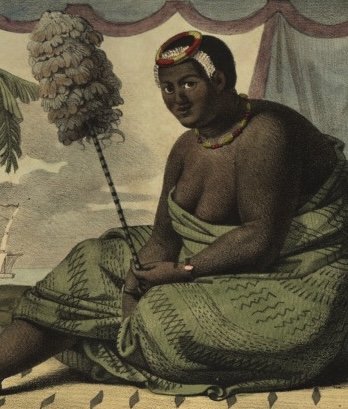A view of 'Iolani Palace in Honolulu, Hawaii. 2021. Gage Skidmore. Cc-by-sa-2.0
https://commons.wikimedia.org/wiki/File:Iolani_Palace_(51872681413).jpg
The official Māhele took place in 1848 but the term is also used as a catch-all for a process that spanned 1845-55. The Board of Commissioners to Quiet Land Titles was created in 1845. It was made to facilitate and arbitrate land claims by private individuals, native and foreign, that would ensue from the coming land reforms. Between January and March of 1848 the Māhele proper occurred as the King reached agreements with 240 ali’i and konohiki (Hawaiian chiefs) concerning their lands, after which they were to submit their claims to the Board.
The Hawaiian royal family and other indigenous elites throughout the islands had more access to the resources necessary to secure their land claims. Ordinary Hawaiians often did not. Language barriers, as well as the cost of surveyors, added to the challenge of navigating the Māhele’s legal requirements. By the 1848 claim deadline, many commoners had not filed either out of frustration, or outright resistance to what they saw as an alien system.
Also in 1848, the king divided his own lands into those owned by the Hawaiian government, and those that were his own personal property. The last 2 major steps in the process of the Mālehe occurred in 1850. First the Legislature passed an act to allow foreigners to acquire land in “fee simple.” Fee simple, meaning as private property in the Euro-American fashion. Finally, the Kuleana Act of 1850 gave Hawaiian commoners who had acquired title to their lands by submitting claims, to sell it, completing their transition to fee simple ownership.
Photograph of William Little Lee and Charles Reed Bishop. Photographer unknown. 1846. Public Domain. https://en.wikipedia.org/wiki/File:William_Little_Lee_and_Charles_Reed_Bishop_1846.jpg
2 Americans who went on to serve in the Hawaiian government during this period were William Little Lee and Charles Reed Bishop. Both hailing from New York State, the young professionals had set out for Oregon in 1846, but found opportunities in Hawai’i before reaching the west coast of North America.
Lee, a lawyer, was soon appointed as judge in O’ahu and made a member of Kamehameha III’s privy council. In 1848 he was appointed as Chief Justice of the Hawaiian Supreme Court. Lee was instrumental in drafting some of the laws of the newly formed constitutional monarchy and served on the land commission that facilitated the Great Mahele. He also helped draft the 1852 constitution which gave the other branches of government increased oversight over the king’s powers. Towards the end of his life, Lee was working on passing reciprocity treaties with the US. He died of tuberculosis in 1857 before the negotiations could be completed.
Charles Reed Bishop found work as a lawyer, then as an agent for the US consul, and then as a customs agent for the Kingdom of Hawai’i. He courted a member of the royal family, Bernice Pauahi Pākī. They were married in 1850. Bishop continued to prosper, founding a bank, and serving on the privy council to several Hawaiian monarchs. He was appointed to the House of Nobles by Kamehameha IV. He and his wife founded the Kamehameha Schools, a school system that educated children of Hawaiian ancestry.
Kamehameha IV, born Alexander ʻIolani Liholiho Keawenui (1834–1863) Hawaii State Archives. Approx. 1863. Public Domain. https://commons.wikimedia.org/wiki/File:Kamehameha_IV_(PP-97-8-002).jpg
Kamehameha IV reigned from 1855-1863 following the death of his predecessor. He worked to balance American subjects’ influence over the kingdom, as they were the largest landowners besides the Hawiian elite, and in many cases far wealthier. His successor, Kamehameha V went even further, refusing to uphold the 1852 constitution. He called a convention to draft a new one in 1864. This constitution abolished the office of kuhina nui, restored some of the king’s autonomy, and converted the House of Nobles and House of Representatives into a single Legislative Assembly.
King Kamehameha V. Charles Weed. 1865. Public Domain. https://commons.wikimedia.org/wiki/File:Kamehameha_the_Fifth.jpg
Kamehameha V died without naming a successor. Choosing the new sovereign from eligible royal family members fell to a vote by the Legislative Assembly. King Lunalilo was elected in 1873, but fell ill with tuberculosis and died in January of 1874.
Another election was held between David Kalakaua and the former queen and widow of Kamehameha IV, Emma Rooke. Kalakaua won the election amid much controversy, leading to the Honolulu Courthouse Riot. Rooke’s supporters targeted legislators that had supported Kalakaua, injuring many. British and American soldiers docked nearby were called in to restore order.
King Kalakaua was staunchly opposed to ceding any land to foreign nations. At the same time, he negotiated a reciprocity treaty with the US that enriched the owners of Hawai’i’s sugar plantations. Most of these were IS, many of whom advocated American annexation of the kingdom.
Sources:
Banner, Stuart. “Preparing to Be Colonized: Land Tenure and Legal Strategy in Nineteenth-Century Hawaii.” Law & Society Review 39, no. 2 (2005): 273–314.
Kashay, Jennifer Fish. “Agents of Imperialism: Missionaries and Merchants in Early-Nineteenth-Century Hawaii.” The New England Quarterly 80, no. 2 (2007): 280–98.
Kessler, Lawrence H. “A Plantation upon a Hill; Or, Sugar without Rum: Hawai ‘i’s Missionaries and the Founding of the Sugarcane Plantation System.” Pacific Historical Review 84, no. 2 (2014): 129–62.






